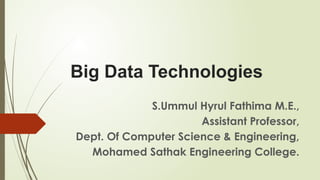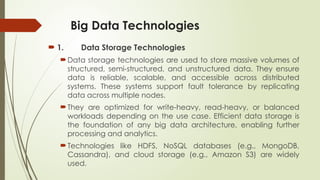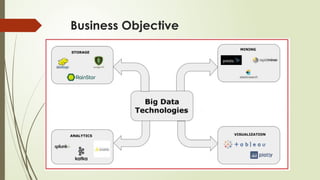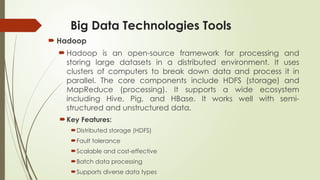Big Data Technologies - Introduction.pptx
- 1. Big Data Technologies S.Ummul Hyrul Fathima M.E., Assistant Professor, Dept. Of Computer Science & Engineering, Mohamed Sathak Engineering College.
- 2. Big Data Technologies 1. Data Storage Technologies Data storage technologies are used to store massive volumes of structured, semi-structured, and unstructured data. They ensure data is reliable, scalable, and accessible across distributed systems. These systems support fault tolerance by replicating data across multiple nodes. They are optimized for write-heavy, read-heavy, or balanced workloads depending on the use case. Efficient data storage is the foundation of any big data architecture, enabling further processing and analytics. Technologies like HDFS, NoSQL databases (e.g., MongoDB, Cassandra), and cloud storage (e.g., Amazon S3) are widely used.
- 3. Big Data Technologies 2. Data Mining Technologies Data mining technologies help in extracting hidden patterns, relationships, and trends from large datasets. They apply machine learning, statistical, and mathematical algorithms to explore the data. These technologies support tasks like classification, clustering, association rule mining, and anomaly detection. They are essential for turning raw data into meaningful and actionable insights. Data mining is commonly used in sectors like marketing, fraud detection, and healthcare analytics. Popular tools include Weka, RapidMiner, KNIME, and languages like R and Python.
- 5. Big Data Technologies 3. Data Analytics Technologies Data analytics technologies are used to analyze, interpret, and gain insights from large-scale data. They cover various types of analytics — descriptive, diagnostic, predictive, and prescriptive. They allow organizations to make data-driven decisions, forecast outcomes, and optimize operations. Analytics platforms can work on real-time or batch data depending on business needs. They are central to business intelligence, customer analysis, risk modeling, and operational optimization. Technologies include Apache Spark, Presto, Hive, and data science tools like R and Python.
- 6. Big Data Technologies 4. Data Visualization Technologies Data visualization technologies help in representing data visually using charts, graphs, maps, and dashboards. They transform complex data into easily understandable visuals for better insight and decision-making. These technologies support real-time, interactive, and multi- dimensional visualization. They are commonly used in reporting, performance monitoring, and storytelling with data. Visualization plays a key role in communicating results of data analysis to stakeholders effectively. Popular tools include Tableau, Power BI, Plotly, and libraries like D3.js, Matplotlib, and Seaborn.
- 7. Big Data Technologies Tools Hadoop Hadoop is an open-source framework for processing and storing large datasets in a distributed environment. It uses clusters of computers to break down data and process it in parallel. The core components include HDFS (storage) and MapReduce (processing). It supports a wide ecosystem including Hive, Pig, and HBase. It works well with semi- structured and unstructured data. Key Features: Distributed storage (HDFS) Fault tolerance Scalable and cost-effective Batch data processing Supports diverse data types
- 8. Big Data Technologies Tools Spark Apache Spark is an open-source data processing engine built for speed and ease of use. It performs in-memory computation, making it faster than Hadoop MapReduce. Spark supports multiple languages like Python, Scala, Java, and R. It includes libraries for machine learning, streaming, SQL, and graph processing. Spark is ideal for both batch and real-time workloads. Key Features: In-memory processing Supports ML, streaming, graph analytics High speed for big data APIs in multiple languages Compatible with many data sources
- 9. Big Data Technologies Tools Presto Presto is an open-source distributed SQL query engine for big data analytics. It allows querying data where it lives — including HDFS, S3, RDBMS, and NoSQL systems. Presto was developed by Facebook for fast interactive queries. It supports ANSI SQL syntax and integrates with Hive metadata. Suitable for OLAP-style analytics and ad hoc queries. Presto separates compute from storage for better scalability. Commonly used in big data platforms like AWS Athena. Key Features: Distributed SQL query engine Connects to multiple data sources Low-latency, interactive querying ANSI SQL support Scalable and open-source
- 10. Big Data Technologies Tools Hive Apache Hive is a data warehouse software built on Hadoop. It provides SQL-like access (HiveQL) to data stored in HDFS. Hive queries are compiled into MapReduce or Spark jobs. It supports tables, partitions, and user-defined functions. Ideal for data summarization, reporting, and ETL. Works well for structured data in a batch environment. Integrates with tools like Hue, Presto, and Spark. Key Features: SQL-like language (HiveQL) Batch-oriented analytics Compatible with HDFS Easy integration with Hadoop tools Supports partitioning and bucketing
- 11. Big Data Technologies Tools Splunk Splunk is a data platform for searching, monitoring, and analyzing machine-generated data. It processes logs and events in real time from diverse sources like servers, apps, and IoT. Splunk indexes the data and provides powerful search and visualization capabilities. Supports alerting, dashboards, and predictive analytics. Used widely for IT operations, security, and compliance. Can handle structured and unstructured log data. Available in both on-prem and cloud versions. Key Features: Real-time log monitoring Searchable indexed data Interactive dashboards Machine learning integration Security and IT operations use cases
- 12. Big Data Technologies Tools KNIME KNIME is an open-source analytics platform for data science and machine learning. It uses a drag-and-drop GUI to build data workflows without coding. Supports data cleaning, transformation, modeling, and visualization. Integrates with Python, R, Weka, and TensorFlow. Suitable for both beginners and advanced users. Often used in bioinformatics, finance, and retail analytics. Commercial extensions provide big data and cloud capabilities Key Features: Visual workflow interface Open-source and extensible Integrates with ML libraries Advanced data preprocessing tools Supports big data and cloud plugins
- 13. Big Data Technologies Tools Elasticsearch Elasticsearch is a distributed search and analytics engine built on Apache Lucene. It indexes data in near real-time and supports full-text search. Commonly used for log analytics, site search, and business intelligence. Supports RESTful APIs for querying and integration. Works seamlessly with Logstash and Kibana (ELK stack). Handles structured, unstructured, and time-series data. Highly scalable and fault-tolerant. Key Features: Real-time indexing and search Scalable, distributed architecture Full-text and structured search REST API access Integration with Kibana for visualization
- 14. Big Data Technologies Tools R Language R is a statistical computing language widely used in data science and analytics. It provides extensive libraries for data manipulation, visualization, and modeling. Ideal for statistical analysis, forecasting, and machine learning. R supports both command-line scripting and GUI environments like RStudio. Extremely popular in academia, healthcare, and finance. Key Features: Strong in statistical modeling Extensive data visualization support Open-source with large package library Integrates with Hadoop and Spark Ideal for advanced analytics and reporting
- 15. Big Data Technologies Tools Blockchain Blockchain is a decentralized, immutable ledger used for secure data transactions. Each block contains a record, timestamp, and link to the previous block. Data stored in blockchain is tamper- proof and verified by consensus. Used in finance, supply chain, healthcare, and identity management. Supports smart contracts that execute code automatically. Combines cryptography, consensus, and decentralization. Increasingly explored for secure big data environments. Key Features: Decentralized and transparent Tamper-resistant ledger Cryptographic security Consensus-driven validation Ideal for secure data sharing and audit trails
- 16. Big Data Technologies Tools Plotly Plotly is a graphing and visualization library for creating interactive charts. Supports Python, R, JavaScript, and other environments. Used for dashboards, scientific charts, and business analytics. Works well with web apps, Jupyter Notebooks, and BI tools. Enables drill-downs, animations, and real-time visual updates. Offers open-source and commercial versions (Dash framework). Popular for visualizing complex statistical and ML data. Key Features: Interactive and real-time plots Multiplatform support (Python, JS, R) Dashboards and web app integration Highly customizable Open-source with cloud version
- 17. Big Data Technologies Tools RapidMiner RapidMiner is a visual data science platform for machine learning and analytics. Offers a no-code, drag-and-drop interface for building models. Supports data prep, clustering, classification, regression, and more. Integrates with R, Python, Spark, and Weka. Widely used in business intelligence and research. Offers both open-source and enterprise editions. Strong automation and model evaluation tools. Key Features: Visual modeling environment Rich ML algorithm library Seamless integration with external tools Enterprise-ready features Useful for beginners and experts alike
- 18. Big Data Technologies Tools Cassandra Cassandra is a highly scalable, distributed NoSQL database designed for high availability. It uses a peer-to-peer architecture, meaning all nodes are equal with no single point of failure. Cassandra handles massive amounts of data across multiple data centers and cloud regions. It uses a wide-column store data model ideal for time-series or sensor data. Offers tunable consistency, allowing trade-offs between availability and consistency. It is optimized for high write throughput and fast data ingestion. Widely used in applications requiring uptime, like IoT, banking, and messaging. Key Features: Peer-to-peer distributed architecture Horizontal scalability High write performance Tunable consistency levels Fault-tolerant and decentralized
- 19. Big Data Technologies Tools Tableau Tableau is a powerful business intelligence (BI) and data visualization platform. It allows users to connect to various data sources and create interactive dashboards. With its drag-and-drop interface, it makes data exploration easy for non-technical users. Supports real-time analytics and storytelling with visual cues. Compatible with cloud and on-premise data warehouses like Snowflake, Redshift, and SQL Server. It enables sharing insights securely across teams or through the web. Popular in business, finance, marketing, and operations analytics. Key Features: User-friendly drag-and-drop interface Interactive dashboards and filters Real-time data visualization Connects to multiple data sources Secure sharing and collaboration
- 20. Big Data Technologies Tools MongoDB MongoDB is a document-oriented NoSQL database built for scalability and flexibility. It stores data in BSON (binary JSON) documents, supporting nested structures and dynamic schemas. Ideal for handling semi-structured data like user profiles, product catalogs, and logs. MongoDB is horizontally scalable using sharding and supports replica sets for high availability. It supports powerful querying, indexing, and aggregation capabilities. Integrates easily with applications via native drivers in multiple languages. Common in web, mobile, and IoT applications for fast development cycles. Key Features: JSON-like document storage Schema-less and flexible High availability via replication Auto-sharding for scalability Rich query and aggregation tools
- 21. THANK YOU




















